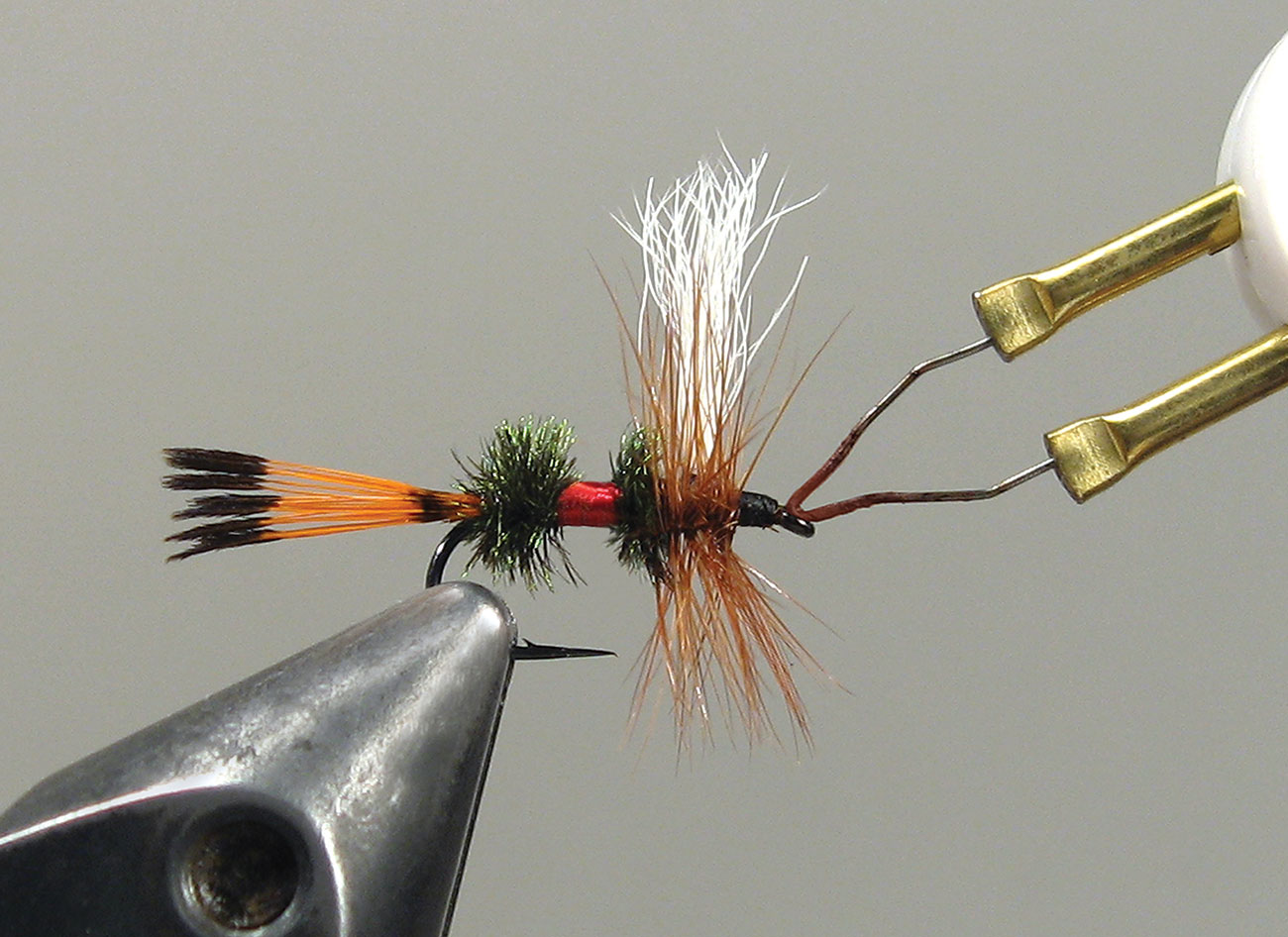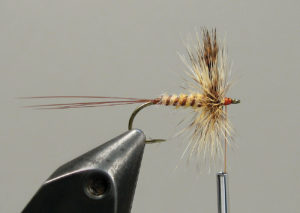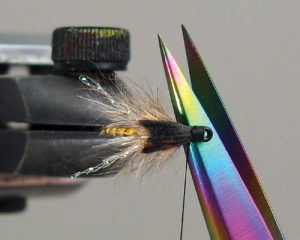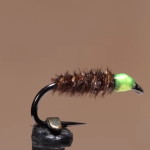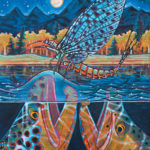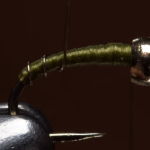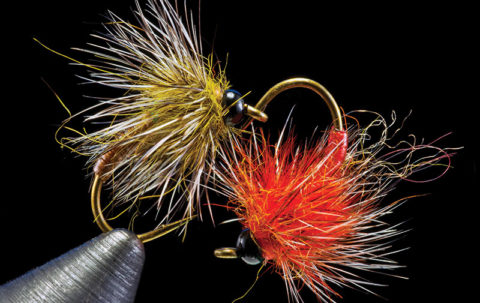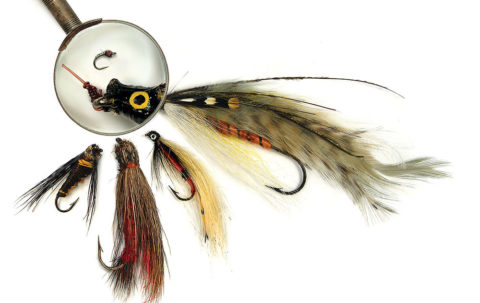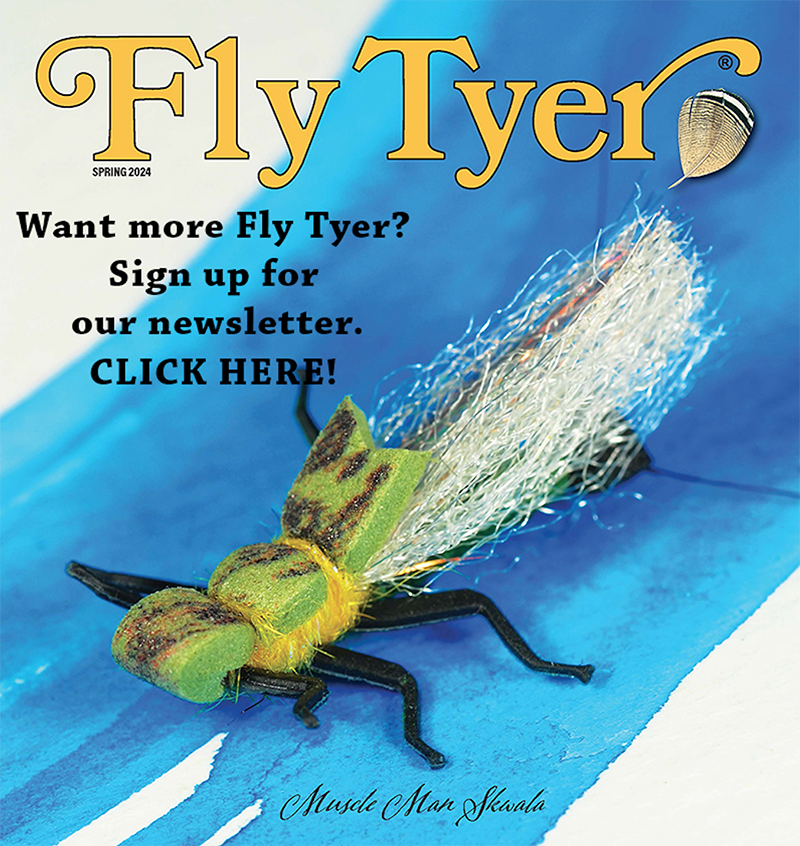Do neat looking heads on flies really matter? The fish might not care, but you should.
[by Bill “Bugs” Logan]
The trout won’t care about anything I’m going to show you. You might, though. Whether or not our flies have pretty little heads matters only to us. Small things only matter to us. We’re the ones who admire the warm glow of Tonkin cane and nickel fittings and a flawless coat of varnish. Or do you think more about boron rods and whether wide-arbor reels may be foolish overkill on a trout stream? Right now, I care most about my tailing loop. That’s no small thing, but I’m trying to convince myself that I’ll conquer it. I’m determined to manage a better casting stroke, just as I intend to get a final season out of my leaky worn-out waders, although I don’t know why I worry about being either dry or warm; I almost always lose my footing and get wet anyway.
The truth is that it’s in everyone’s power to at least change the small things. That must be why we take great pleasure in them. Maybe this will be the year I cast out a bit farther and with fewer tangles. And so what if my flies answer as much to an aesthetic as to an evil intent? If the trout knew what I planned, they would think I’m very evil. But they don’t know I’m coming and won’t until it’s too late—if I can manage it. Then we’ll see just what small moments are made of.
The first one will come as I open my fly box in the early morning. Perhaps a faint whisper of cool nighttime air will be lingering down by the river’s edge, but as I tilt my box and my little darlings catch the sunlight, I will believe anything might happen. Isn’t that something? Every time it goes just like that.
Look at those big, ugly flies in the opening photograph. My dad tied those. Now imagine a box filled to brimming with them and a wide-eyed tyke peeking in over the rim. I suppose it might be kind to say that dad wasn’t much of
a fly tier and leave it at that, but he still had a treasure chest, didn’t he? As crude as they are, his flies still have charm. He didn’t care if they were hump-backed or block-headed, and he meant it when he said that flies looked more real if their heads had all sorts of stuff sticking out. And eyes, let me tell you about eyes: paint them yellow on any fly you can, and the trout will like it. Do you think that’s funny? No bug I know has a gold bead for a head, but fish like that, too. Yellow eyes aren’t much of a stretch, and neat flies don’t count unless you like tying them that way. You have to believe that if you fish them well, anything can happen. Let me tell you how this works.
A Golden Afternoon, a Big Fish, and Being Grateful
I’m thinking about a Royal Coachman that was placed in my small hand a very long time ago. I bet the smile I’m wearing now is the same as it was then. My dad had finally decided I was old enough to take me fishing and I was having a miserable time trying to keep up. I had to act big, but it was too much of a job. Dad was no fool, and he knew what was what, but he also expected toughness in his fishing partner. I was learning that lesson as much as any other.
Now, maybe it’s my memory speaking, or maybe it really did turn into a golden afternoon when dad made a great show of giving me a very special fly that had been buried deep within a special box. Perhaps I’m remembering more than one trip and have built the perfect memory, but it doesn’t matter. All that matters now, as then, is that this fly was “guaranteed.” That’s what dad told me, and I believed him.
After he tied it on for me, we crept up to a spot in a river bend that was very good for trout. I remember being extra careful to tread softly, just as I was shown, so the fish couldn’t hear me coming through the undercut bank.
I didn’t have to cast at all. I just had to dabble my Coachman in the water.
Bang-o! A trout actually ate it!
Memory of the big fight comes in flashes. There was pandemonium and many attempts to lead the fish to the net. Above all, there was glee riddled with fear that it might get away. Finally, surprise was mixed with overwhelming happiness when my trout was finally laying in the net. And then it was time for my next hard lesson. Dad said you should always, always let the day’s first fish go. It has to do with being grateful and knowing you’re fortunate.
Bill “Bugs” Logan is the perfect blend of artist, poet, and angler. He is also one hell of a fly tier. When he’s not on the water, you might catch him in his studio in New Jersey. To learn more, go to his website, www.billloganart.com.
Plan From the Start
 The Royal Coachman is lovely, fit for either frame or fish. Not a herl fiber is out of place and the wings peek rakishly above the hackle. What do you think of that slick little head? Doesn’t it look as if it came off a miniature salmon fly?
The Royal Coachman is lovely, fit for either frame or fish. Not a herl fiber is out of place and the wings peek rakishly above the hackle. What do you think of that slick little head? Doesn’t it look as if it came off a miniature salmon fly?
Small heads on classic dries are absolutely lovely but can be problematic. Without care and sneaky tricks, you’re as likely to wind up with a crowded finish on a fly that was looking darned fine right up until the end.
Making pin-sized heads comes with time and practice; trust me on this. Meanwhile, leave ample room for good, practical heads. One trick, if your fly has an upright wing, is to tie the latter in like on the fly below. With the wing in place, a body can’t creep forward and you have a landmark for centering the hackle. And notice that I bind my wing in with the butt end facing forward rather than to the rear. This forces me to keep my distance behind the hook eye and eliminates the tendency for the wing to tilt forward with use over time. Follow my method and the worst that might happen is the wing will kick back a tad.
Cleaning Up the Head of a Fly
Here I’ve finished our fly. It’s no thoroughbred, but it’s serviceable and would be pretty were it not for the stray trapped hackle fibers. Let’s fix them!
You’ll be amazed at how closely heads, even those on tiny flies, can be trimmed and cleaned up using a small amount of caution and either a heated bodkin or a battery operated cauterizer. This is a great trick for clearing away obscured hook eyes.
Working in Tight Quarters
This is what it looks like when you realize you’re in trouble. The simple posted wing on this American March Brown was attached too far forward, and now there’s scant room for both the hackle and head. What can we do?
To start, I’ll use my trusty cauterizer to get rid of the wing’s butt and reduce bulk. Actually, it’s not a bad idea to make a habit of doing this whenever you tie.
Here I’ve wrapped the hackle. I’ve also brushed back and held the fibers clear while adding a neat head. Make no mistake: this fly is serviceable. But after a few fish, as it gets beat up, slimed, waterlogged, washed off, and re-dressed with floatant, a sad thing may occur: the hackle fibers you see forced back by the head wraps might kick back farther still. We will no longer have an evenly flared hackle that holds our fly upright on the water. Instead, the lopsided hackle might allow our fly to ride cock-eyed or on its side.
Here we see the same fly below. I’ve removed some of the thread wraps, clipped any hackle fibers that might fold back, and reformed the head. This is much better. While no prizewinner, we still have a neat head and a passable hackle that yields a workman-like pattern.
Now for a serious question: which fly looks more buggish? If you said mine, you’re generous and also blinded by devotion to method. Perhaps I tied this shaggy, chunky old Coachman as a lad long ago, but I suspect it’s one of my dad’s, even though it has no painted eyes. Regardless, I think that old fellow is the real killer and the fish will still clobber it.
No Head is Better Than One
 This old soldier (in the upper left) has been recalled to illustrate a point: just because you’re supposed to finish a fly with a neat head doesn’t mean you should! Sometimes a head just adds unsightly and unnecessary bulk. If you tie Elk-Hair Caddises or similar hair-winged patterns such as the Early Brown Stonefly (at the top right), it’s far neater to tie off without forming a head at all. The same is true for parachute-hackled flies, especially small ones, in which tying off beneath the hackle is a damned nuisance. Rather than attempting a full-blown head and knot in such cases, why not finish with a few half-hitches and leave it at that? You’ll find it’s a relief to easily slip them under the hackle and around the hook.
This old soldier (in the upper left) has been recalled to illustrate a point: just because you’re supposed to finish a fly with a neat head doesn’t mean you should! Sometimes a head just adds unsightly and unnecessary bulk. If you tie Elk-Hair Caddises or similar hair-winged patterns such as the Early Brown Stonefly (at the top right), it’s far neater to tie off without forming a head at all. The same is true for parachute-hackled flies, especially small ones, in which tying off beneath the hackle is a damned nuisance. Rather than attempting a full-blown head and knot in such cases, why not finish with a few half-hitches and leave it at that? You’ll find it’s a relief to easily slip them under the hackle and around the hook.
Last of all is the same size 32 midge that was in the opening photo. Do you see it? There is barely room for half-hitches let alone a head. The same is true for flies several sizes larger. Enough said, right?
Minimizing Bulk
 Wing buds often cause trouble when tying nymphs. They’re bulky and right where we wish they weren’t as we try wrapping things up. Ah, but glance above and you’ll see a turkey strip bound in behind what will become the thorax on a standard nymph. Notice it has been tied in butt first. A similar feather strip, held in the wing burner, is oriented in the same direction. Now consider this: the strip on the bottom has been attached where it’s thickest. When pulled forward as a back strap, we will secure and clip it where it’s much slimmer. This will make all the difference, leading to the sweet head seen on the finished fly in the next photo.
Wing buds often cause trouble when tying nymphs. They’re bulky and right where we wish they weren’t as we try wrapping things up. Ah, but glance above and you’ll see a turkey strip bound in behind what will become the thorax on a standard nymph. Notice it has been tied in butt first. A similar feather strip, held in the wing burner, is oriented in the same direction. Now consider this: the strip on the bottom has been attached where it’s thickest. When pulled forward as a back strap, we will secure and clip it where it’s much slimmer. This will make all the difference, leading to the sweet head seen on the finished fly in the next photo.
 On the nearly completed nymph (bottom left), we use the same idea with added refinements. Instead of pulling the feather strip forward to form a wing case, we notched a V in the strip and then tied it to the top of the fly with the tip pointing forward. Look how the feather has compressed at the tie-in point. Even after folding over and securing the white biot on top of the fly, the head remains very slim.
On the nearly completed nymph (bottom left), we use the same idea with added refinements. Instead of pulling the feather strip forward to form a wing case, we notched a V in the strip and then tied it to the top of the fly with the tip pointing forward. Look how the feather has compressed at the tie-in point. Even after folding over and securing the white biot on top of the fly, the head remains very slim.
In a Pinch
At some point you’ll crowd the hook eye, especially on small flies. Even though I didn’t really need to, for demonstration’s sake, I wrapped over the eye on this hook. Now it’s time for a touch of magic.
When you find yourself in the same tight spot at the hook eye, pinch the head hard between your nails just behind the eye while applying a series of short, sharp tugs to the thread.


